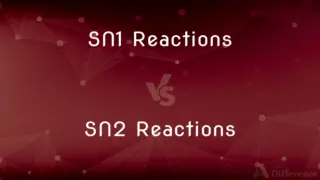Greedy Method vs. Dynamic Programming — What's the Difference?
By Tayyaba Rehman — Published on January 6, 2024
Greedy Method makes the optimal choice at each step for immediate benefits, while Dynamic Programming breaks problems into simpler subproblems and stores their solutions to avoid redundant calculations.

Difference Between Greedy Method and Dynamic Programming
Table of Contents
ADVERTISEMENT
Key Differences
Greedy Method is a problem-solving approach that makes the most advantageous choice at each step, aiming for the overall optimal solution. It doesn't reconsider choices once made and often leads to a local optimum. On the other hand, Dynamic Programming is a method of solving complex problems by breaking them down into simpler subproblems and storing the results of these subproblems to avoid redundant work.
The Greedy Method is easier to implement and usually more efficient in terms of computational resources. It's used when a problem guarantees an optimal solution through local optimizations, like in the case of the Kruskal’s or Prim’s algorithms for finding the Minimum Spanning Tree. In contrast, Dynamic Programming is used in scenarios where the problem can be divided into overlapping subproblems, like the Fibonacci sequence or the Knapsack problem.
Dynamic Programming can be implemented using either a top-down approach with memoization or a bottom-up approach. It is particularly effective for problems with optimal substructure and overlapping subproblems. Conversely, the Greedy Method follows a single pass approach, making the best choice at each step without considering future consequences.
While the Greedy Method can lead to suboptimal solutions in some problems, it's highly efficient in problems where local optimization aligns with global optimization. Dynamic Programming, although providing a more accurate solution for a wider range of problems, can be more complex and consume more memory, especially in problems with a large number of subproblems.
Greedy Method is generally preferred for problems with a 'greedy choice property,' ensuring that locally optimal choices lead to a globally optimal solution. In contrast, Dynamic Programming is chosen for problems where decisions affect future choices, requiring a more comprehensive approach to find the global optimum.
ADVERTISEMENT
Comparison Chart
Approach
Makes locally optimal choices at each step
Breaks problems into subproblems; stores results
Efficiency
Generally more efficient; less memory usage
More thorough; can be more memory-intensive
Problem Types
Used when local optimum guarantees global optimum
Effective for overlapping subproblems
Solution Accuracy
May lead to suboptimal solutions
Typically finds the optimal solution
Implementation Complexity
Simpler, single-pass approach
More complex, involves memoization or tabulation
Compare with Definitions
Greedy Method
Aims for local optima in hopes of finding a global optimum.
The greedy method quickly found a near-optimal solution.
Dynamic Programming
Ideal for problems with overlapping subproblems.
Dynamic programming was perfect for the overlapping subproblems in the shortest path problem.
Greedy Method
Often used for optimization problems.
We applied a greedy method for the job scheduling task.
Dynamic Programming
Can be implemented top-down or bottom-up.
We used a bottom-up dynamic programming approach for optimization.
Greedy Method
Chooses the best option at each step.
A greedy method was used to solve the coin change problem.
Dynamic Programming
More comprehensive and accurate than greedy methods.
Dynamic programming found the optimal solution, unlike the greedy method.
Greedy Method
Doesn't reconsider past decisions.
The greedy algorithm selected edges without revisiting choices.
Dynamic Programming
Solves problems by dividing them into smaller subproblems.
Dynamic programming efficiently computed the Fibonacci sequence.
Greedy Method
Efficient but may not always find the best solution.
In the knapsack problem, the greedy approach didn't yield the best result.
Dynamic Programming
Stores solutions of subproblems to avoid repetition.
The algorithm used dynamic programming to store intermediate results.
Common Curiosities
What is Dynamic Programming?
A method to solve problems by breaking them into simpler, overlapping subproblems.
What types of problems are suitable for Dynamic Programming?
Problems with optimal substructure and overlapping subproblems.
When should I use the Greedy Method?
For problems where local optimum decisions lead to a global optimum.
Is Dynamic Programming more efficient than the Greedy Method?
It's more thorough but can be less efficient in terms of computational resources.
Can the Greedy Method solve the Knapsack problem optimally?
No, it may not provide the optimal solution for the Knapsack problem.
Can Dynamic Programming be used for non-overlapping subproblems?
It's less effective for non-overlapping problems; other methods may be better.
Can the Greedy Method be applied to graph problems?
Yes, it's often used in graph problems like finding minimum spanning trees.
What is the Greedy Method?
It's an approach that makes the most beneficial choice at each step.
Is the Greedy Method faster than Dynamic Programming?
Often yes, because it makes decisions quickly without backtracking.
Is memoization a part of Dynamic Programming?
Yes, memoization is a technique often used in top-down dynamic programming.
Does the Greedy Method guarantee an optimal solution?
Not always; it can lead to suboptimal solutions in some cases.
Why is Dynamic Programming used in complex problems?
Due to its ability to handle complexity and ensure optimal solutions.
How do I choose between Greedy Method and Dynamic Programming?
Analyze if the problem has overlapping subproblems and requires global optimization.
Are there problems unsolvable by both Greedy Method and Dynamic Programming?
Yes, some problems may require different algorithms or heuristics.
Do I need to store all subproblem solutions in Dynamic Programming?
Yes, storing subproblem solutions is key to the method's efficiency.
Share Your Discovery

Previous Comparison
Go-Back-N Protocol vs. Selective Repeat Protocol
Next Comparison
SN1 Reactions vs. SN2 ReactionsAuthor Spotlight
Written by
Tayyaba RehmanTayyaba Rehman is a distinguished writer, currently serving as a primary contributor to askdifference.com. As a researcher in semantics and etymology, Tayyaba's passion for the complexity of languages and their distinctions has found a perfect home on the platform. Tayyaba delves into the intricacies of language, distinguishing between commonly confused words and phrases, thereby providing clarity for readers worldwide.













































